As you as loyal readers know, I often write about things in my blog that I am currently dealing with and that do not necessarily have to do with a bike trip or a bike set-up. But sometimes they are reflections or thoughts that might be interesting for one or the other of you.
At the moment I’m thinking about disc brakes, or more precisely mechanical disc brakes.
When I had my Norwid touring bike built four years ago, it was already equipped with devices for mounting a disc brake at my request. As a classic – and thus naturally conservative – touring cyclist at the time, I was of course already familiar with disc brakes, but on a touring bike they were still nothing. At least I ventured a cautious excursion into hydraulics with the Magura HS33.
Two years ago, my metamorphosis into a bikepacker began and I built myself a bikepacking bike. Of course, it had to have disc brakes. But which ones? After my experiences with the HS33 on my touring bike, I didn’t like hydraulic brakes (miserable braking performance, high abrasion) – and I was also worried about defective cables on tour (which is of course not really legitimate). So I decided to go for mechanical disc brakes.
They were not only easy to install, but also to repair in case of doubt. A controllable system that suited me, because I wanted to be prepared for all eventualities. And compared to a V-brake or hydraulic rim brake, the mechanical disc brakes were a revelation: very good braking performance even under load and acceptable pad wear.
Now the experienced rider of hydraulic disc brakes will probably laugh or at least grin, because compared to these, mechanical disc brakes tend to be the ones that provide poorer braking performance, or their braking performance takes place under worse conditions.
Advantages and disadvantages of mechanical disc brakes
And of course nowadays the question arises: why use mechanical disc brakes at all when there are much better hydraulic ones?
Let’s face it: when it comes to maximum braking power, dosing and control, hydraulic disc brakes are the best choice – regardless of whether they are used on a touring bike or a bikepacking runabout. Properly adjusted, they also require very little maintenance.
On the other hand, they are more expensive than mechanical disc brakes, somewhat more complicated to install and maintain, and of course they always require appropriate brake levers.

Mechanical disc brakes, on the other hand, are cheaper (most of the time), their braking performance – if properly adjusted – comes close to that of hydraulic brakes, they are often lighter than hydraulic brakes and easier to install and maintain. And you can operate these brakes with almost any brake lever that controls mechanical brakes. This is especially interesting for all those who want to switch from a rim-destroying V-brake (attention, judgement! 🙂 ) to a disc brake and don’t want to replace the entire shift/brake unit right away. However, this is also their weak point, because the friction in the cable costs power and energy and thus reduces the performance.
And what’s really good: if something grinds, you can immediately adjust the brake again. Simply unscrew, pull the lever and tighten again.
4 reasons for mechanical disc brakes
Path less Pedaled has made an informative video on the subject of mechanical vs. hydraulic brakes:
My decision to go with mechanical brakes was driven by three points: first, I wanted a brake that I could repair somewhere in the middle of nowhere if I was in doubt. Secondly, I wanted a brake that was easy to install. And thirdly, I just didn’t want to bother with hydraulics and start with mechanical.
Avid vs. TRP: Which brake suits me?
If you study the topic a bit, you usually end up with three brakes: the Avid BB7, the TRP Spyre and the TRP Spyke. And if the budget is a bit bigger, then the Paul Klamper.
All of the above are suitable for demanding use on a touring or bikepacking bike. But the TRP Spyre is more for road bikes with road bike brake levers, the Spyke is more for MTB and their brake levers. The BB7 also makes these distinctions between road and MTB.
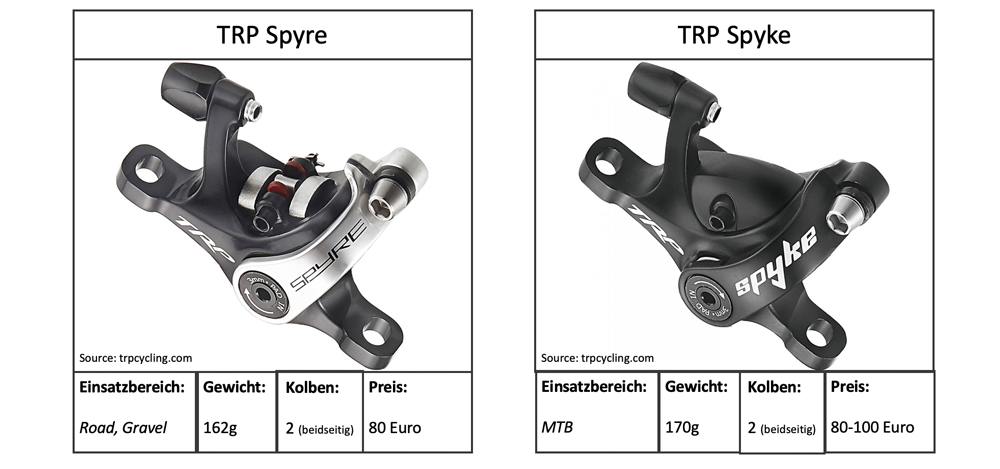
Which of these brakes is the “best” is debatable. I have ridden both the BB7 Road (on the Salsa Marrakesh) and the TRP Spyre. Both brakes are of course good and also brake well in the wet. The most important difference, however, is that the BB7 brakes on one side, whereas the TRP Spyre brakes on both sides.
The installation is very simple for both and the pads can be adjusted on both sides with an Allen key or a wheel on one side for the BB7. Both brakes are post-mounted, but can be mounted on IS or flat-mounts using an adapter.
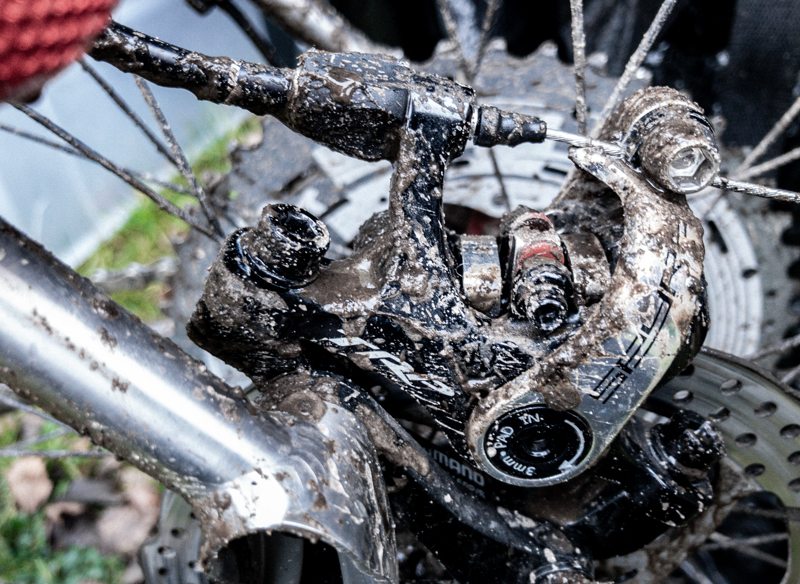
However, there are differences in weight: The TRP Spyre weighs 162g (per body) (reweighed), the BB7 Road S weighs 197g. In terms of price, both are about the same at around 70/80 euros per brake body.
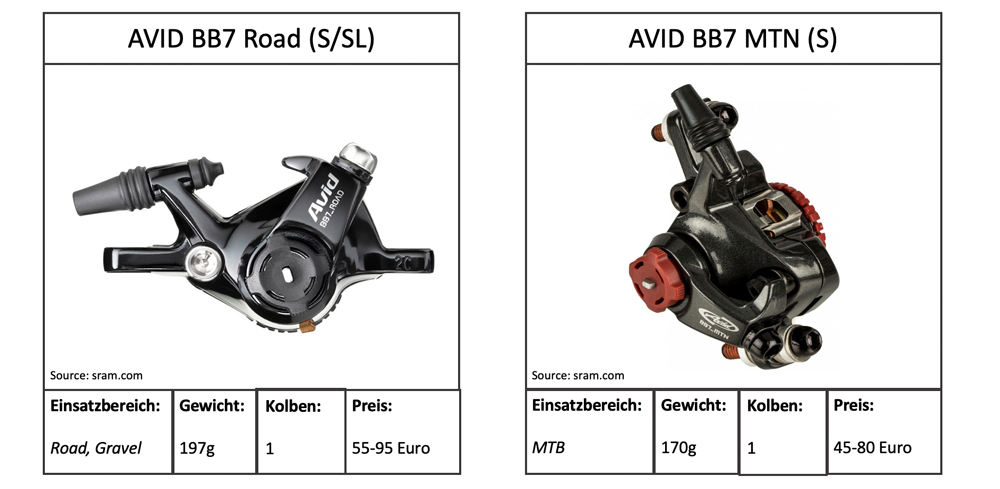
I chose the TRP Spyre because of the double-sided brake pistons, which can be controlled well with the SRAM Rival brake levers. I use the brakes with 160mm discs and have mastered the Tuscany Trail as well as the Atlas Mountain Race with them. The braking performance is very good from my point of view, it works really well and locks the wheels without any problems, but also has enough dosage. However, the performance also depends on the Bowden cables. I usually use cables from Jagwire.
On the Bombtrack Beyond I use a TRP Spyre C, which has carbon components and is a bit lighter than the conventional TRP Spyre I have installed on the Salsa Fargo. And as you can see, I can only warmly recommend this brake.
If you want something special…
If you are absolutely into mechanical brakes and have enough budget, you should have a look at the PAUL Klamper. PAUL has many years of experience in manufacturing brakes and offers with the Klamper probably one of the best and most expensive mechanical disc brakes on the market.
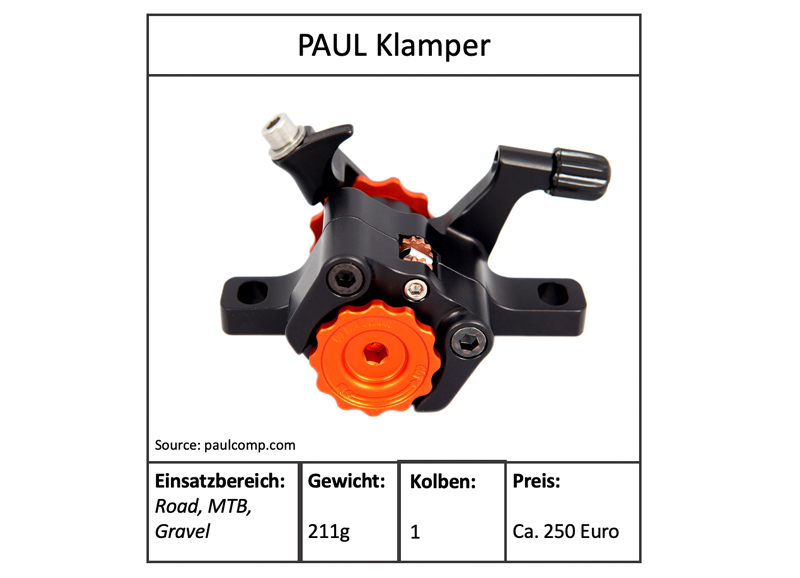
The Klamper is available as Post Mount/IS and Flat Mount version. A distinction is made between short pull, long pull and Campagnolo. The brake body is made of aluminium and steel, comes in different colours and weighs 211g.
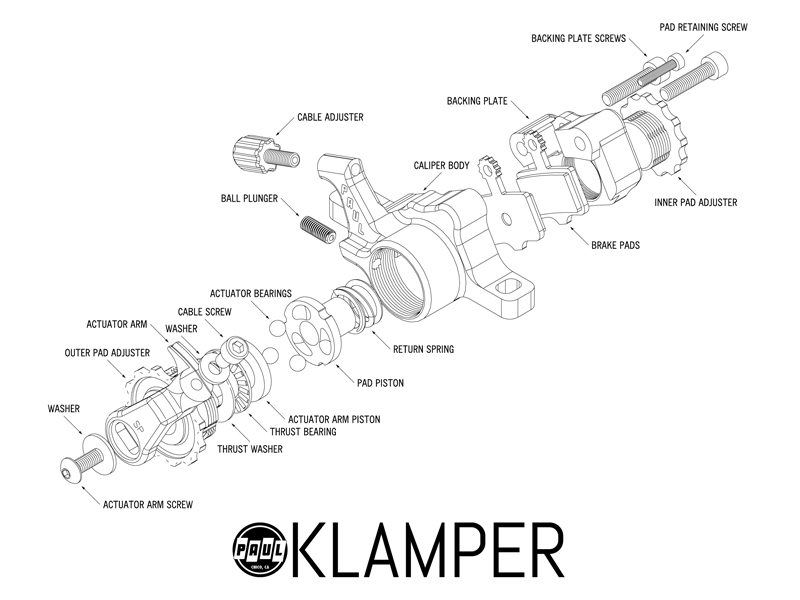
And: the Klamper brakes on one side, which is justified here with “more power”. There is also a detailed explanation for this:
The price, however, is high, although understandable for this work: around 240 euros per brake body are due for the Klamper.
And what other brakes are there?
Besides the ones mentioned above, there are of course other mechanical disc brakes.
For example, the Avid BB5 (MTB/road). However, it does not have the pad adjustment options of the BB7. Nevertheless, with a price of approx. 30 euros per body, the BB5 is definitely an alternative for the price-conscious user.
The Hayes MX-5, which is intended for MTBs, is similar. At around 35 euros, it is similarly priced to the BB5 and, at 197g, also weighs a similar amount.
A simple brake for road and cross is the Tektro Lyra, which weighs 148g and costs around 45 euros. I have not been able to find any empirical experience with this brake. But you should know that TRP is Tektro’s premium brand.

Completely unknown to me is the Clarks CMD 22. But it brakes with 2 pistons and at about 35-40 euros per body it is not that expensive (about 80 euros for v/h). I found a quite informative test report on this brake at Seven Day Cyclist. Sounds quite interesting, even if the assembly seems a bit more complex.
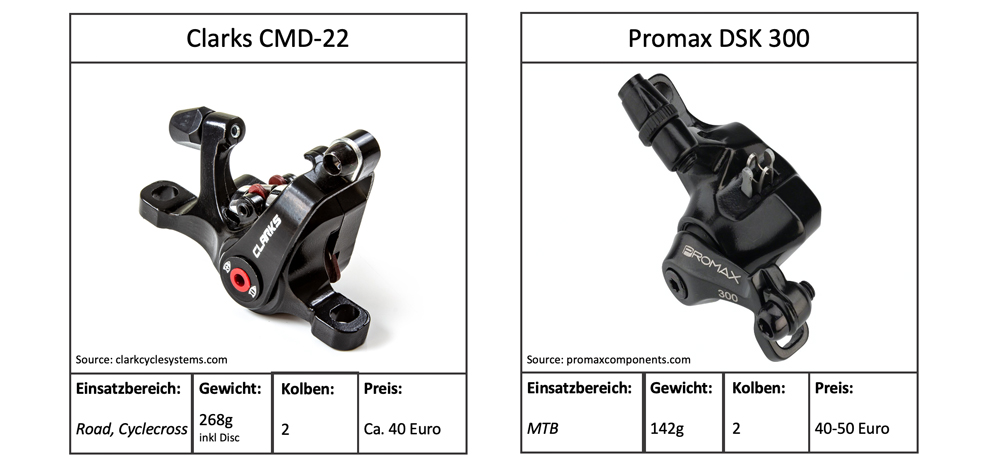
I just got a new test bike with the Surly Bridge Club. It brakes with the mechanical Promax 300 brakes. The Promax 300 weigh 142g per body and cost around 30 euros.
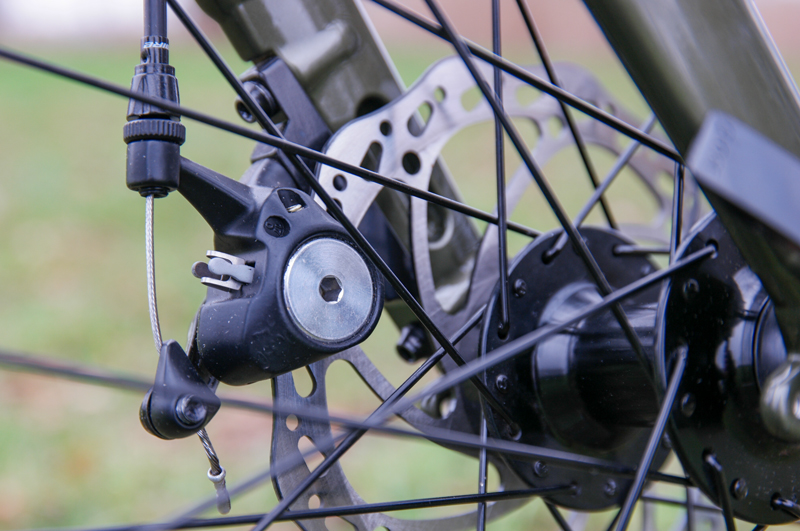
Promax is a component supplier and also builds mechanical disc brakes under the type name Render. I had these on the Salsa Journeyman.
And then there is Shimano…
…and with it some more mechanical brake models like the BR-R317 from the Shimano Sora 3500 group, which is preferably used on road bikes and crossers and with 183g per body is not particularly heavy. It has a flat/slim design and the so-called Shimano Linear Response (SLR) technology, which is supposed to ensure better dosing and easier operation of the brake.
Or the BR-CX77 from the Shimano Ultegra 6800 group for use on cyclocrossers. It weighs only 159g per body, is post mount and has a 14% flatter design than other brakes.
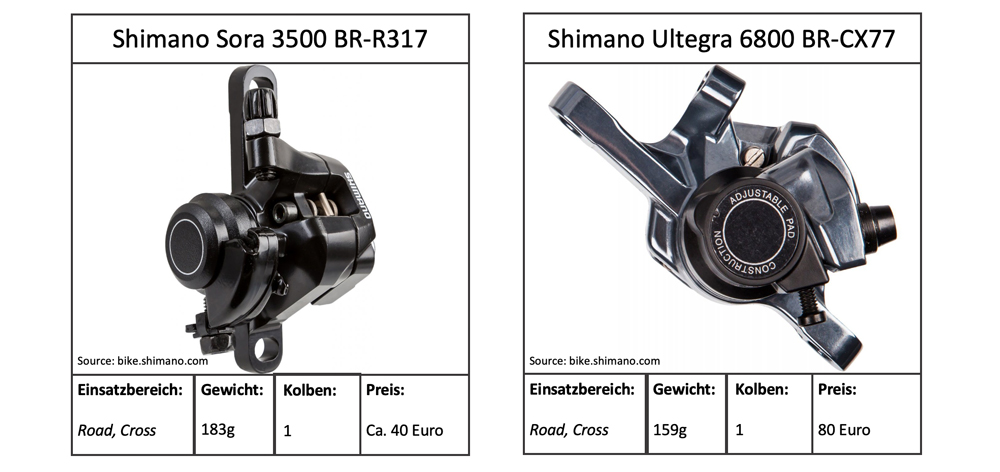
The BR-TX805 is a mechanical disc brake from the Tourney TX group. It is designed for MTB with centre lock system and weighs 295g per body (presumably including disc. I have not been able to find an exact specification).
Also for MTB, but also trekking and city is the BR-M375 from the Shimano Altus group. Like the Tourney, this has a wider pad spacing and weighs around 200g.
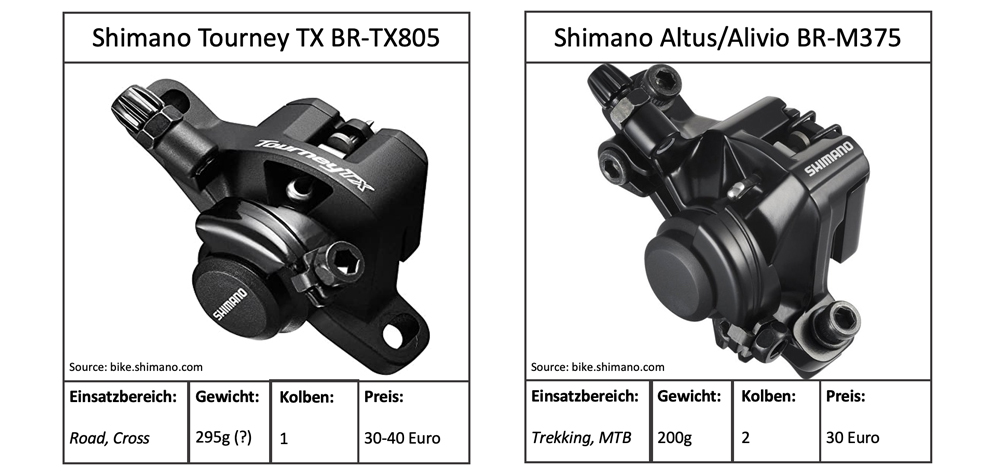
You’ll notice – if you take a closer look, there is a surprisingly large selection of mechanical disc brakes.
Hybrid is (also) a solution
In Morocco, after 1.5 days in the Race, I had the problem that my hands started to hurt and cramp, especially on long technical descents. The reason for this was the continuous use of the brakes and the permanent maintenance of pressure points. This was where the disadvantage of the mechanical brakes became particularly apparent, because they require a little more braking force than the hydraulic ones due to the friction in the brake cables.
How can I change this and still keep the current setup?
A little oil can’t hurt, especially if it leads to more braking power and dosage and is used in so-called hybrid brakes. These brakes are a combination of mechanical and hydraulic brakes. Here, the brake pads are pressed against the disc hydraulically and the hydraulics are controlled mechanically. This sounds quite complicated at first, but it has been tried and tested for years and works very well in my experience so far.
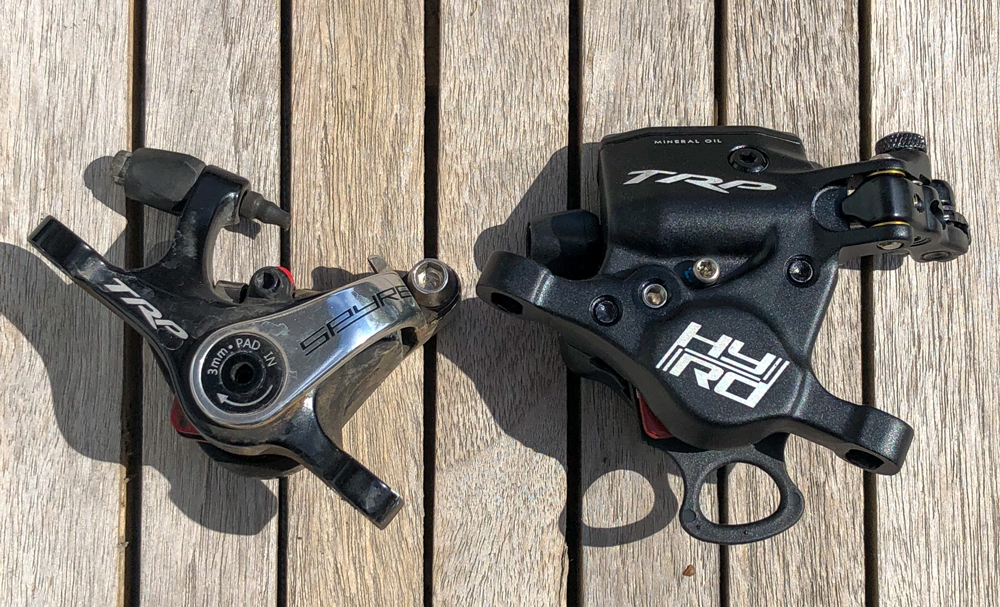
When it comes to hybrid brakes, one name always comes up first: TRP HY RD. These hybrid brakes for road bike brake levers have been around for a long time. Mechanically, pistons are actuated, which compress the oil in a small container and thus trigger the brakes.
Despite this additional oil package, the brakes are not particularly wide and, like all TRP mechanical disc brakes, they can be mounted easily and quickly. Of course, with 216g per body (reweighed), the TRP HY RD are slightly heavier than the TRP Spyre, but given the performance, this is negligible.
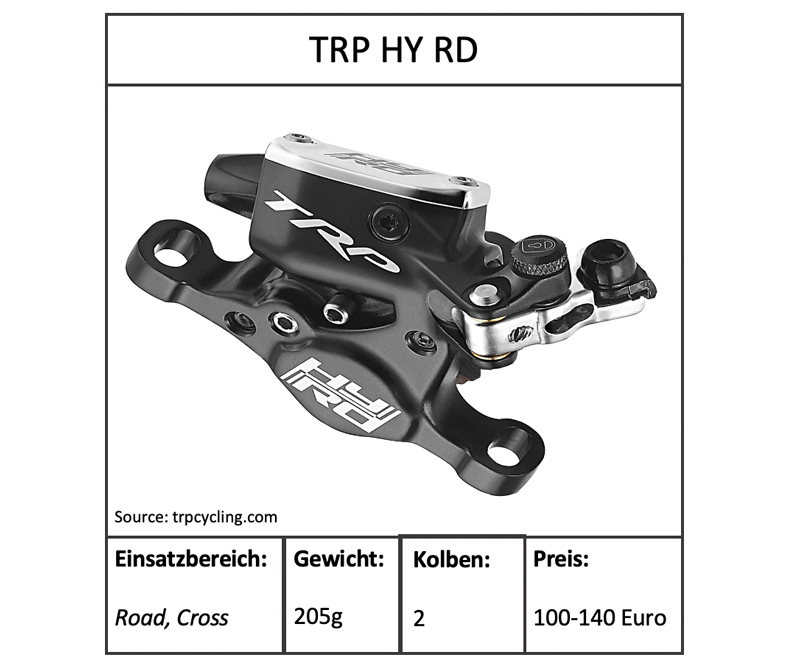
There are three things I particularly like about this brake, which I’ve been riding on the Salsa Fargo for a few hundred kilometres now:
- Very easy and quick installation.
- Automatic brake pad adjustment. Works uncomplicated and without grinding and squeaking.
- Locking function prevents the pads from coming together during transport or wheel removal.
I was particularly struck by how much less force I have to use when braking, especially if you brake from above a lot, like I do. By that I mean braking with your hands on top of the brake/shift levers. To ensure this performance, you should preferably connect the TRP HY RD with Jagwire Slick Lube and compressionless Bowden cable sleeves. This reduces friction and thus loss of efficiency.
The oil reservoir is very solidly sealed and the risk of bleeding is rather unlikely. If necessary, the brake can be bled and the oil changed.
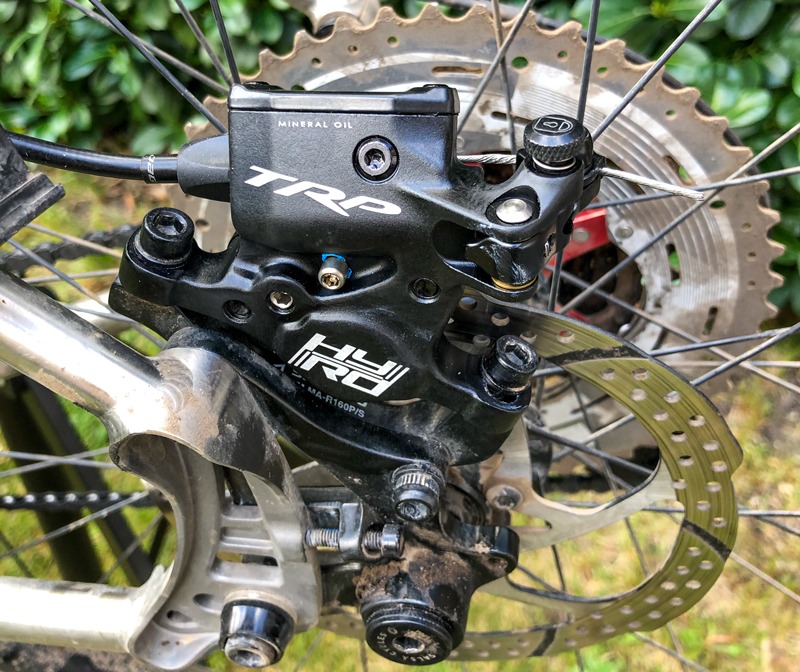
And not only is less power needed, but braking performance has also improved. The brakes have the power of a hydraulic brake, pack a punch and are much finer in dosage and pressure point control. Only the factory-supplied pads should be replaced with better ones.
In short: The TRP HY RD is currently “my” brake, because it currently combines the best of both worlds. The simplicity and weight of a mechanical brake with the power and lightness of a hydraulic brake.
Noble hybrid from Japan
In my research, I found only one other hybrid brake: The Yokozuna Motoko and Ultimo. The difference between Motoko and Ultimo is the number of pistons. The standard Motoko model has 2 pistons, the top model Ultimo has 4.
In terms of design, the Yokozuna brakes are already more beautiful and elegant than the TRP.
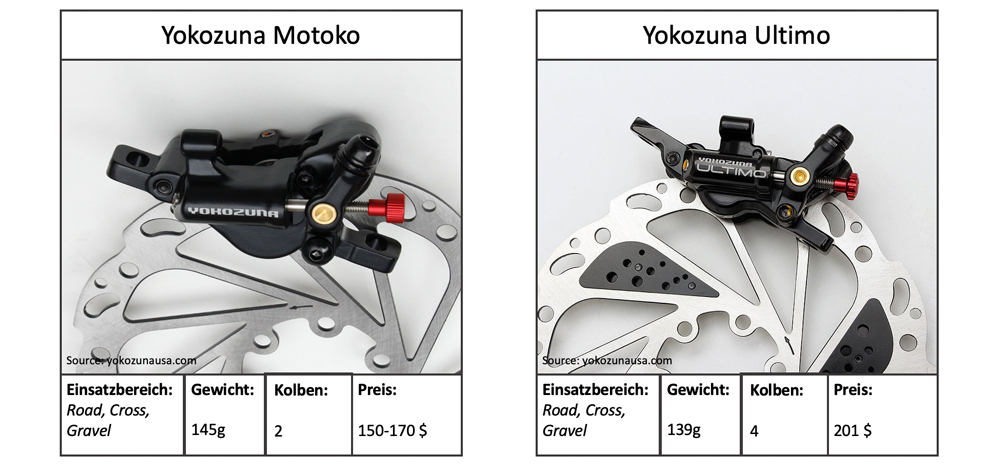
However, they are also more expensive: around 150 Euros for the Motoko, around 200 Euros for the Ultimo – per caliper, of course.
Moreover, at 142g (Motoko) and 139g (Ultimo) they weigh considerably less than the HY RD.
Here you can find a good test report on the Motoko brake and here one on the Ultimo brake.
So…
…if you are interested in mechanical or hybrid disc brakes, I hope this article has helped you. I learned a lot from researching, installing, riding, reading and writing about them.
Oh, and by the way: I don’t mention brake discs in the text. In any case, all the brakes mentioned work with 140 to 160mm brake discs. With adapters they can also brake larger discs.
If you find unclear or wrong information or have other data on the brakes, or know of other models not listed here, let me know and write it in the comments.

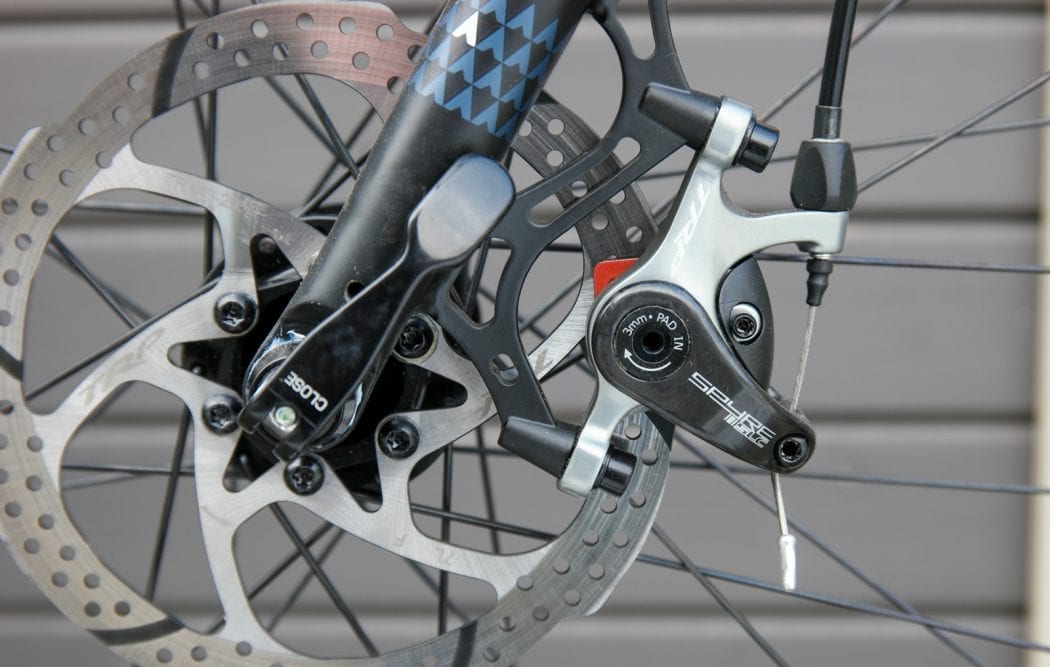
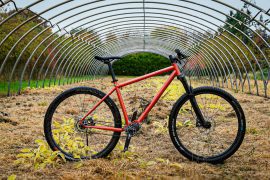
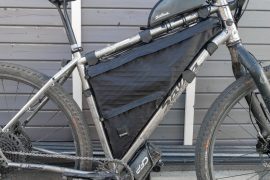
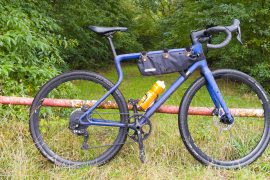
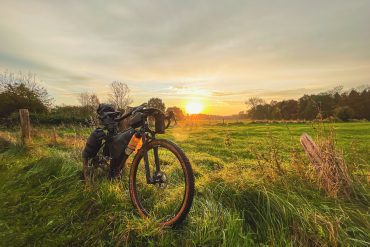
Could you use a ultegra R8000 shifter with the TRP spyre set up.?
Hi Stefen,
The Spyre is designed for almost all mechanical road bike brake levers and should also work with the Ultegra. However, it is best to check this again with TRP.
Martin